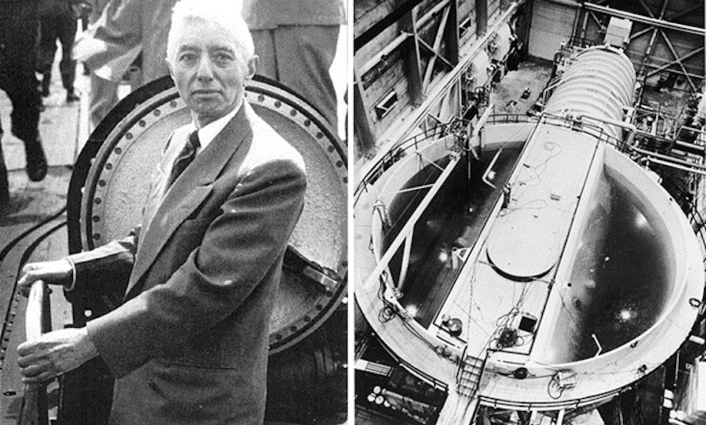This is the sixth installment in Asia Times Science Editor Jonathan Tennenbaum’s series “Fusion Diary.” Read a series introduction, part 1, part 2, part 3, part 4. and Part 5. Part 6 is the conclusion of an interview with Paul Methven, director of Great Britain’s Spherical Tokamak for Energy Production (STEP) program.
In Parts 4 and 5 Methven describes the challenges of the decision-making needed to make STEP a reality. This installment concludes with a fascinating analogy between STEP and two of the most complex scientific and engineering projects in post-World War II history: the creation of the first nuclear-powered submarine, led by US Admiral Rickover, and the Apollo Program, which landed astronauts on the Moon.
Jonathan Tennenbaum: What about the physics? Do you have a sufficient scientific basis, at this point, to be confident of success? And how will you be able to react to advances that might occur midway in your project, such as the discovery of more favorable plasma modes?

Paul Methven: From the standpoint of physics it’s based on all the experience with these sorts of machines. It is not speculative. There are uncertainties, though. I think most fusion engineers and scientists would describe it as a nonlinear problem.
We’re building on knowledge gained on machines like MAST Upgrade, but there’s a lot of modeling. Through modeling, we have to demonstrate in particular that the plasma behavior is broadly what we expected it to be.
But I think your broader point is relevant, which is that we’re having to design our machine for a range of potential performance of the plasma. Some of that is actually designing for better than we might hope for, as well as worse. And part of the reason for that is, if you don’t design for better and you do get better, then your tokamak has to be able to deal with the power that comes from the better performance.
Some of our design-stressing criteria are actually about a good day rather than a bad day. If we didn’t get quite the power we expected, that’s fine. Then the thermal loads and mechanical loads and so forth are manageable. But we actually have to design for a really good day on plasma. So some of the design philosophy is about accommodating a range of performance in plasma that can be realized physically.
JT: So you have a larger degree of flexibility than for a future commercial plant.
PM: Absolutely. One of the points in a commercial plant that comes off of the back of a prototype is you then understand where to optimize. So one of the outcomes of our program I call the information baseline. We should understand the technical decisions we made and why we did so at that point, also to understand which decisions we would make differently, knowing what we know now, at that point in the future. The same in terms of cost and schedule because we’ve got a really clear information thread that runs all the way through the program.
JT: Considering the organizational challenges of your project, I am reminded of the US Apollo Moon landing program of the 1960s. All along the way they were dealing with an enormous number of unknowns. At the height of the program, 400,000 people and over 20,000 industrial firms were involved.
Decision-making and coordinating such an endeavor, in the face of so many unknowns, was an astonishing feat. Do you feel there is a comparison with what you are doing now?

PM: In fact, I did give a talk a few weeks ago at a fusion conference where I deliberately invoked Apollo. My other good comparison is the early days of the fission program, particularly the nuclear submarine program, which Rickover drove in the US. Which is also my background.
I chose the Apollo comparison because it’s a really big endeavor which requires national weight behind it, because lots of things were uncertain and because they set a very ambitious timescale and used that to drive innovation. Organizationally, I think there’s a lot to learn from Apollo, which is that despite huge numbers of people being involved, they set up the approach so that everybody understood the single aim.
At the same time, there was a lot of empowerment and autonomy throughout the organization and they gave a great degree of latitude toward some of the project managers throughout the organization and they drove the pace really fast as a result of that.

Some of that you can also see in a way that Admiral Rickover drove the US nuclear submarine program. I think there’s a lot of good lessons to be learned from those endeavors.
JT: When we were talking you mentioned that you came out of the submarine program.
PM: My previous role was as director of submarine acquisition in the UK Ministry of Defense. I was responsible for the design and build programs of all UK nuclear submarines.
JT: Why did you go into fusion?
PM: Firstly because delivering a new energy source for the world matters a lot, and so it was too important to ignore. Secondly, it was too exciting to ignore. Technically it’s incredibly exciting – the complexity of the whole problem, technically, organizationally, industrially.
And because the social benefits that we can and should deliver through this are extraordinary. All that was too exciting to ignore. And then personally, because of my background in complex large-scale technical programs, I felt maybe I had something to offer to it.
Jonathan Tennenbaum, PhD (mathematics), is a former editor of FUSION magazine and has written on a wide variety of topics in science and technology, including several books on nuclear energy.

